Hipster with a drill on Mars
Still, Curiosity is a hipster and, rather, still a girl. Well, who else, having attached a drill to the surface, will immediately begin to photograph their achievements and themselves, next to the result of such titanic works?
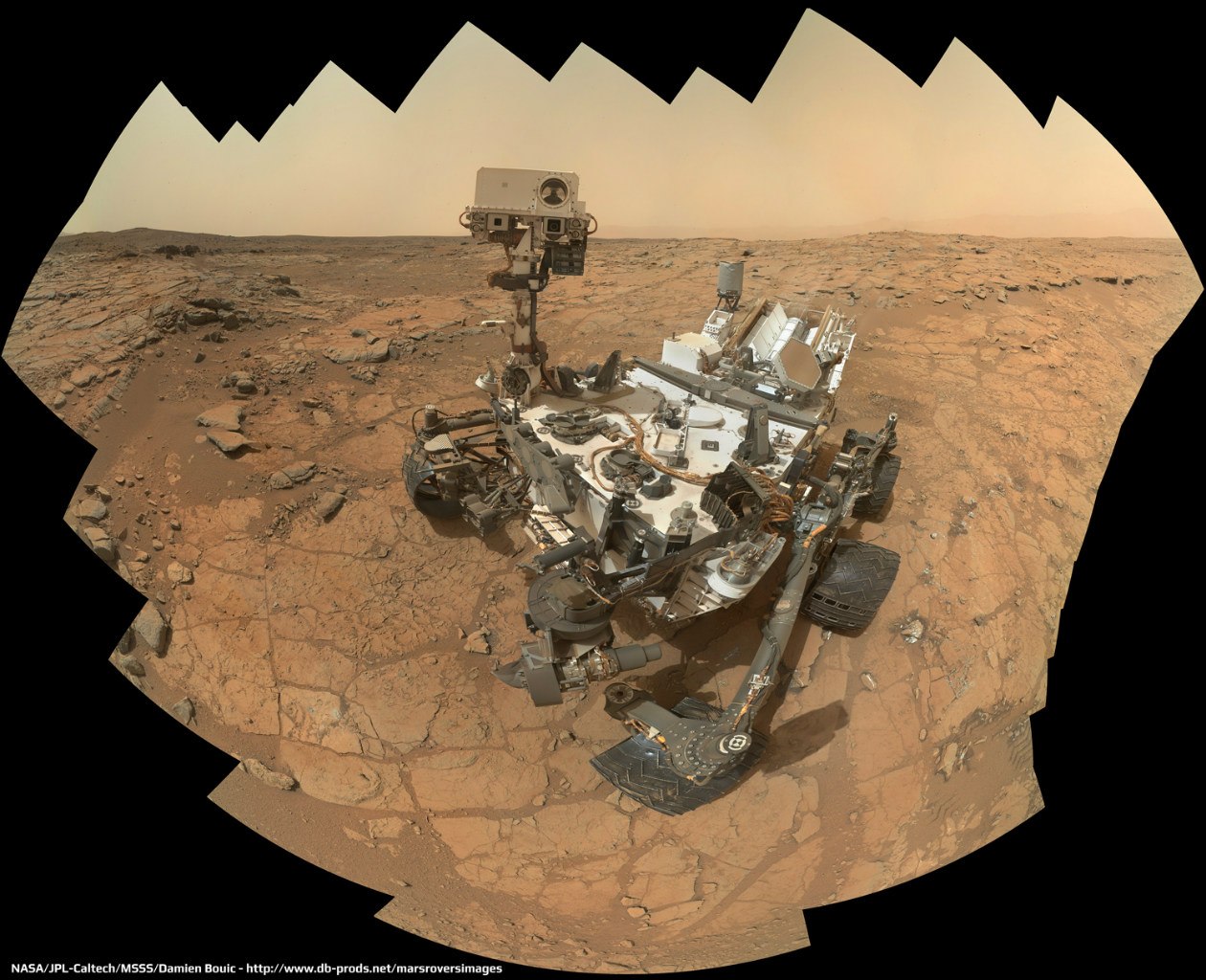
More than two weeks have passed since Curiosity arrived at a site called John Klein. This is the place that was declared the goal of drilling operations almost a month ago. The first shootings were made back in December.

GigaPan
Place it looks like a dried-up puddle or a wall with peeling paint, but a close inspection showed that its structure is much more complicated.
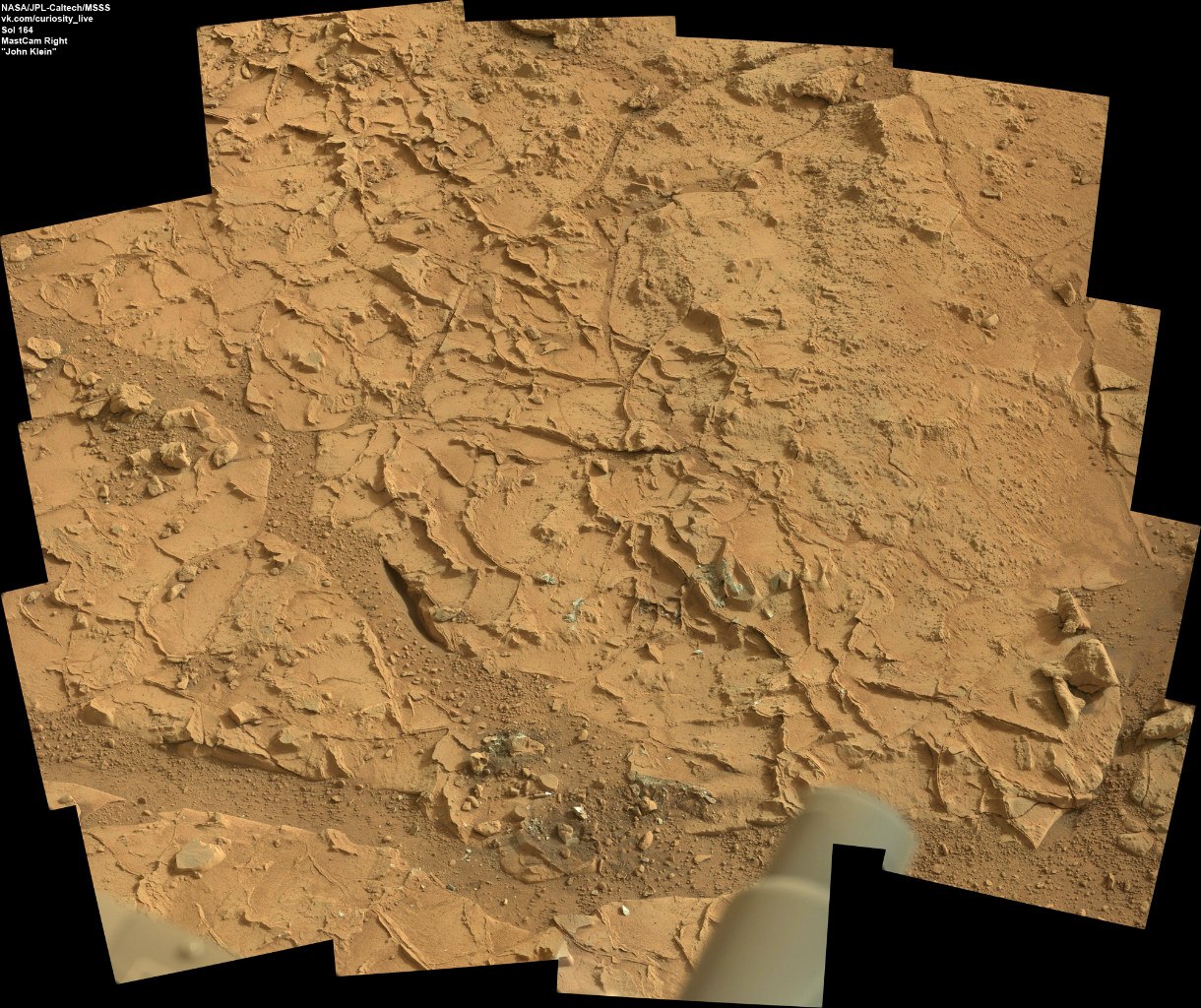
GigaPan
In order to make a preliminary assessment of the surface structure, all the tools were involved.
The first step was "rough processing." The rover is deprived of a geological hammer, but it has 340 kg of live weight and six aluminum wheels.

The damage that the wheels leave to the surface is not just the result of pressure. The rover stops in the place of interest and begins to rotate the wheels in different directions. The principle of such processing is best explained by this instructional video:
After that, not just dents appear, but chips, even on hard rock.

( Anaglyph )
Having violated the surface layer, Curiosity applied a new technique that was not previously used - night ultraviolet shooting. They have already written about this here , but I will still share an HDR image in UV rays:

Various geological rocks tend to glow under the influence of ultraviolet rays. Gypsum has a weak luminescence, and, apparently, its scientists hoped to see.
Then the traditional APXS research cycle went through:

Photo on the desktop.
In total, several goals have been outlined where drilling is likely to take place.

Two of them brushed DRT
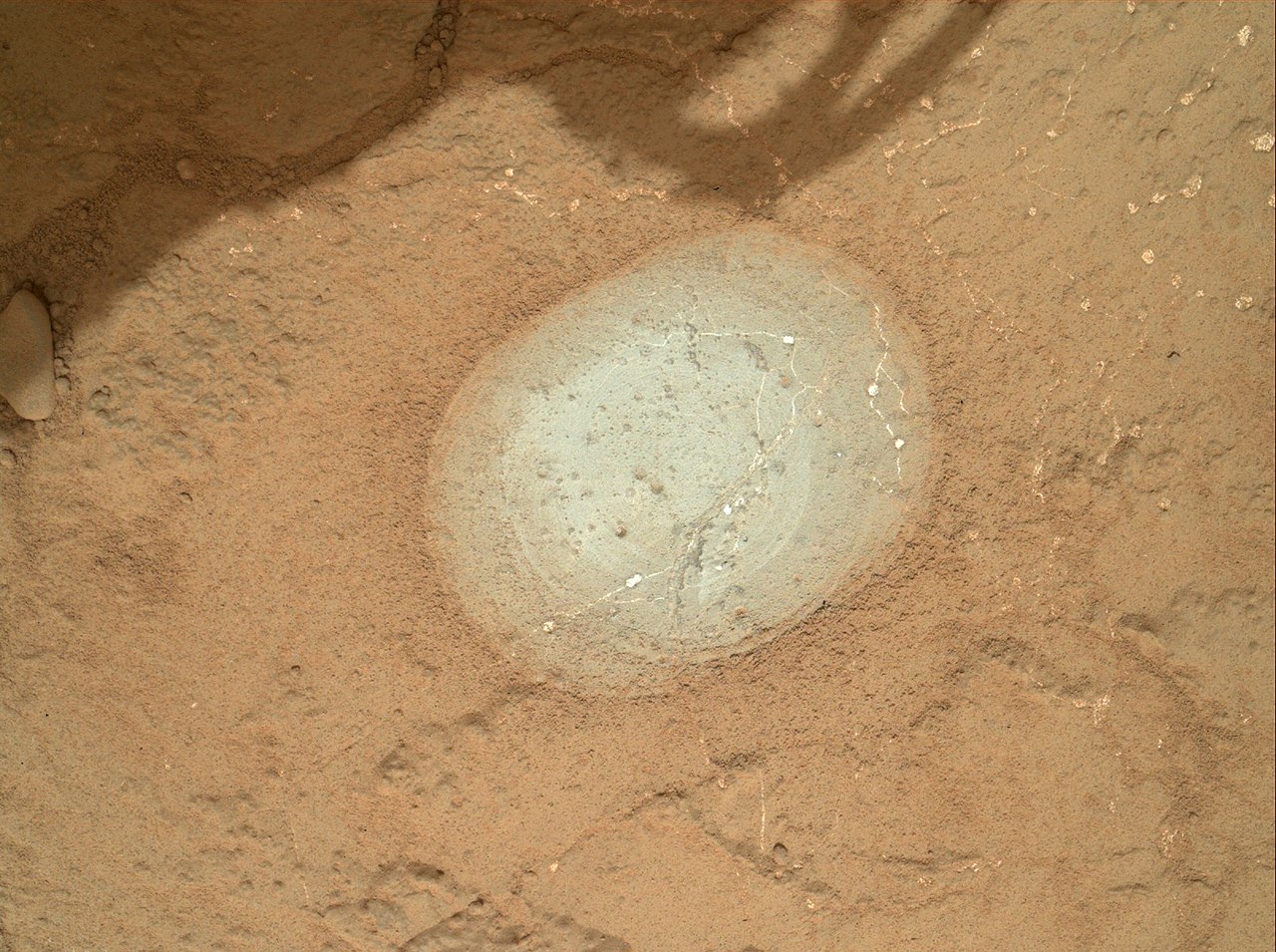
NASA carefully examined the characteristic surface detail of John Klein, which he called "veins like ridges." It is likely that such a feature formed in several stages. At first there was a cracked dry puddle, and then the cracks were again filled with a new breed, most likely, the ubiquitous gypsum.

Trying on the site, Curiosity successfully stood in front of Mount Sharpe. Preliminary shooting with navigation cameras showed that the atmosphere had already cleared enough of dust after the storm and that one could return to large-scale landscapes.
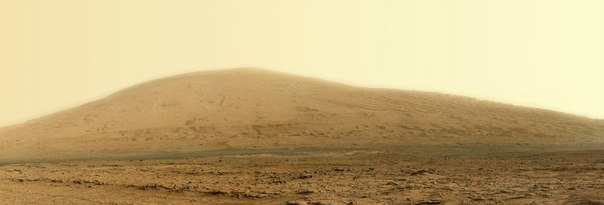
( Large sizes and desktop )
So far, the mountain was removed only with the left mast camera. I'm still looking forward to shooting right. There is one site that has long attracted attention.

It was shot with the right camera even earlier, at the initial stage of the journey, and this image opened up great scope for imagination.
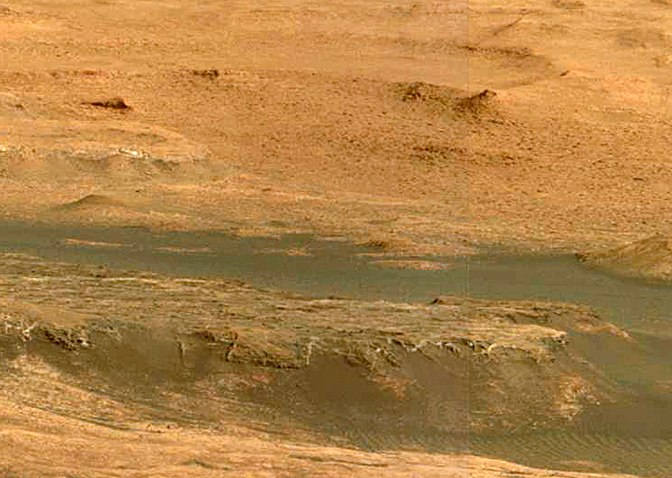
It is easy to imagine that some ancient fall of the forest, a giant layer of turf, or something similar is depicted here. But the length of these "branches" should be several tens of meters. Now the rover is about 300 meters closer and I want to see it in more detail. Although, probably, he will soon come even closer. But he will not approach them.
This structure is located about 3 km from the rover, and on the way to it are dangerous black dunes, which NASA does not dare to poke.

This place is the closest to Curiosity, where ancient clays come to the surface, which, potentially, may contain hydrocarbon traces of the former Martian life. And the “forest” is most likely just clay streaks that stretch out under million-year rains. But, I repeat, the rover will not go there. Clays are waiting for him for 8 kilometers from here and he will get to them well if by the end of 2013.
Finally, after admiring the surroundings and choosing a convenient place, Curiosity took out a drill:

And he did what many secretly or openly hoped for: he penetrated Mars.

The media immediately wrote "Drilling has begun." But what kind of drilling is there if there was no rotation of the drill, but it deepened by 4 millimeters? In total, two attempts were made:
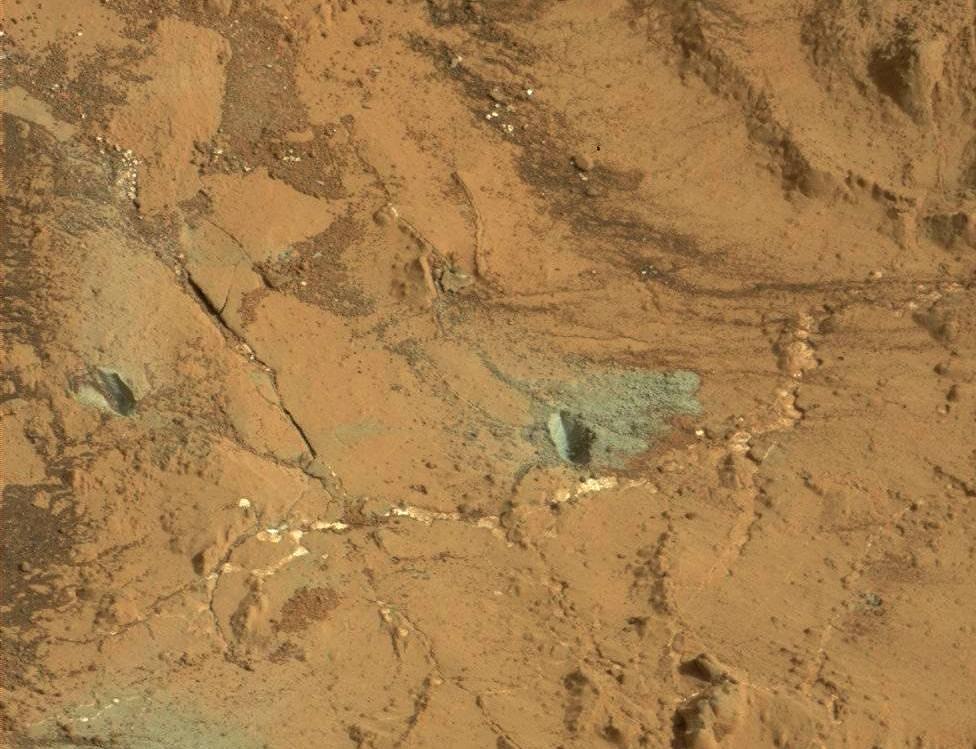
The MAHLI camera made highly detailed macro photographs of the recesses:
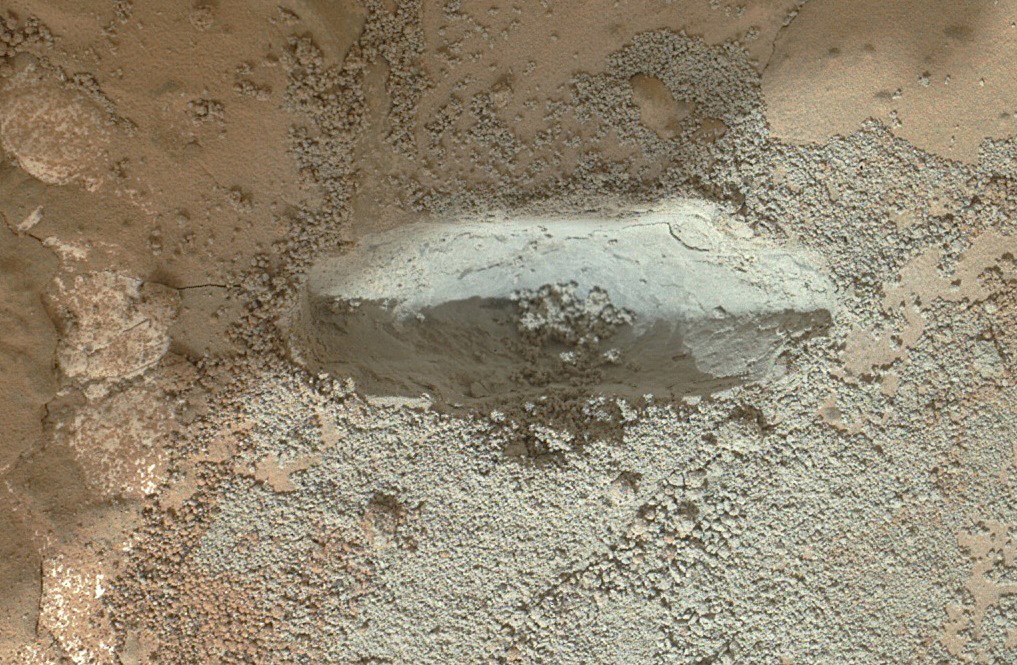
( Yes, this is an oblong hole from the drill, not an oval tubercle. Sometimes perception plays funny jokes. )
It is interesting that the structure of the soil resembles clay. If you are lucky, it turns out that this is really her, and you do not have to wait a whole year. But it may be another loose breed, so I do not want to reassure anyone.
And then ... Curiosity took a self portrait! Well, of course, what else needs to be done on Mars, when the whole Earth is looking forward to the beginning and results of drilling operations!
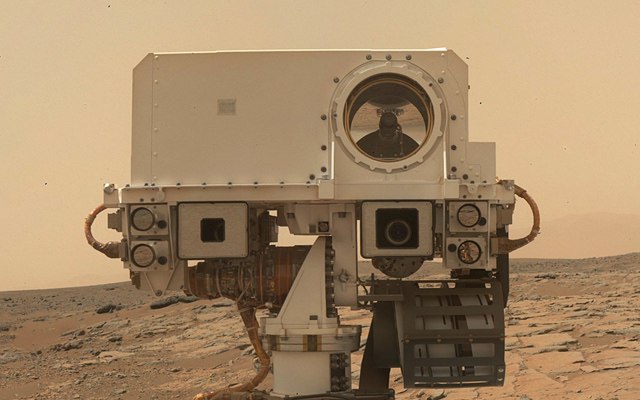
Full portrait on GigaPan
If you look closely, you can see the reflection of Mount Sharpe in the ChemCam mirror.

But Martians and Nasov photographers cannot be found there. But it turns out to see his camera MAHLI

Anticipating a new stream of questions, I answer.
So:
Most likely, drilling operations will begin from day to day, although NASA seems to have reported that a test drilling of the stone that Curiosity brought with it will be carried out.

It is guaranteed there is no organic matter, and its analysis will determine the cleanliness of the SAM and CheMin devices. If Curiosity does this, then Martian drilling will be delayed for another week or more. But NASA has repeatedly departed from previously announced plans, so it remains only to observe.
Read more about the device of the drill and the reasons why NASA is so scrupulous and slow in drilling, you can read here: Curiosity and a puncher .
PS I propose a difficult quest: can we get by in the comments without sparkling jokes about oil and democracy?
PPS And yes, sorry that is so long: a lot of things have accumulated, but more often it doesn’t work.
Phew I almost forgot. Well, after all, they made out a piece of iron sticking out of stone:

There are no better photos yet. The metal on Mars can be a meteorite or glandular nodule, akin to those iron balls that found Opportunity on the Meridian plateau. It is also possible that this is fulgurite - an elongated glass tube that occurs during a lightning strike in the sand.
UPD . It happened! The first well on Mars (HDR).


More than two weeks have passed since Curiosity arrived at a site called John Klein. This is the place that was declared the goal of drilling operations almost a month ago. The first shootings were made back in December.

GigaPan
Place it looks like a dried-up puddle or a wall with peeling paint, but a close inspection showed that its structure is much more complicated.

GigaPan
In order to make a preliminary assessment of the surface structure, all the tools were involved.
The first step was "rough processing." The rover is deprived of a geological hammer, but it has 340 kg of live weight and six aluminum wheels.

The damage that the wheels leave to the surface is not just the result of pressure. The rover stops in the place of interest and begins to rotate the wheels in different directions. The principle of such processing is best explained by this instructional video:
After that, not just dents appear, but chips, even on hard rock.

( Anaglyph )
Having violated the surface layer, Curiosity applied a new technique that was not previously used - night ultraviolet shooting. They have already written about this here , but I will still share an HDR image in UV rays:

Various geological rocks tend to glow under the influence of ultraviolet rays. Gypsum has a weak luminescence, and, apparently, its scientists hoped to see.
Then the traditional APXS research cycle went through:

Photo on the desktop.
In total, several goals have been outlined where drilling is likely to take place.

Two of them brushed DRT

NASA carefully examined the characteristic surface detail of John Klein, which he called "veins like ridges." It is likely that such a feature formed in several stages. At first there was a cracked dry puddle, and then the cracks were again filled with a new breed, most likely, the ubiquitous gypsum.

Trying on the site, Curiosity successfully stood in front of Mount Sharpe. Preliminary shooting with navigation cameras showed that the atmosphere had already cleared enough of dust after the storm and that one could return to large-scale landscapes.

( Large sizes and desktop )
So far, the mountain was removed only with the left mast camera. I'm still looking forward to shooting right. There is one site that has long attracted attention.

It was shot with the right camera even earlier, at the initial stage of the journey, and this image opened up great scope for imagination.

It is easy to imagine that some ancient fall of the forest, a giant layer of turf, or something similar is depicted here. But the length of these "branches" should be several tens of meters. Now the rover is about 300 meters closer and I want to see it in more detail. Although, probably, he will soon come even closer. But he will not approach them.
This structure is located about 3 km from the rover, and on the way to it are dangerous black dunes, which NASA does not dare to poke.

This place is the closest to Curiosity, where ancient clays come to the surface, which, potentially, may contain hydrocarbon traces of the former Martian life. And the “forest” is most likely just clay streaks that stretch out under million-year rains. But, I repeat, the rover will not go there. Clays are waiting for him for 8 kilometers from here and he will get to them well if by the end of 2013.
Finally, after admiring the surroundings and choosing a convenient place, Curiosity took out a drill:

And he did what many secretly or openly hoped for: he penetrated Mars.

The media immediately wrote "Drilling has begun." But what kind of drilling is there if there was no rotation of the drill, but it deepened by 4 millimeters? In total, two attempts were made:

The MAHLI camera made highly detailed macro photographs of the recesses:

( Yes, this is an oblong hole from the drill, not an oval tubercle. Sometimes perception plays funny jokes. )
It is interesting that the structure of the soil resembles clay. If you are lucky, it turns out that this is really her, and you do not have to wait a whole year. But it may be another loose breed, so I do not want to reassure anyone.
And then ... Curiosity took a self portrait! Well, of course, what else needs to be done on Mars, when the whole Earth is looking forward to the beginning and results of drilling operations!

Full portrait on GigaPan
If you look closely, you can see the reflection of Mount Sharpe in the ChemCam mirror.

But Martians and Nasov photographers cannot be found there. But it turns out to see his camera MAHLI

Anticipating a new stream of questions, I answer.
So:
Most likely, drilling operations will begin from day to day, although NASA seems to have reported that a test drilling of the stone that Curiosity brought with it will be carried out.

It is guaranteed there is no organic matter, and its analysis will determine the cleanliness of the SAM and CheMin devices. If Curiosity does this, then Martian drilling will be delayed for another week or more. But NASA has repeatedly departed from previously announced plans, so it remains only to observe.
Read more about the device of the drill and the reasons why NASA is so scrupulous and slow in drilling, you can read here: Curiosity and a puncher .
PS I propose a difficult quest: can we get by in the comments without sparkling jokes about oil and democracy?
PPS And yes, sorry that is so long: a lot of things have accumulated, but more often it doesn’t work.
Phew I almost forgot. Well, after all, they made out a piece of iron sticking out of stone:

There are no better photos yet. The metal on Mars can be a meteorite or glandular nodule, akin to those iron balls that found Opportunity on the Meridian plateau. It is also possible that this is fulgurite - an elongated glass tube that occurs during a lightning strike in the sand.
UPD . It happened! The first well on Mars (HDR).

